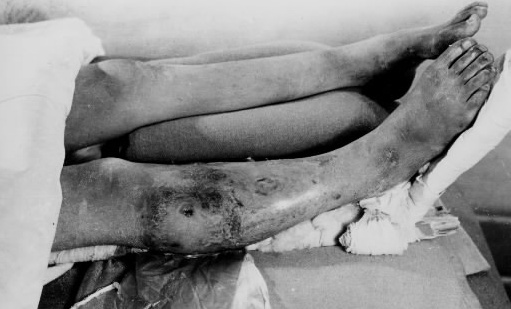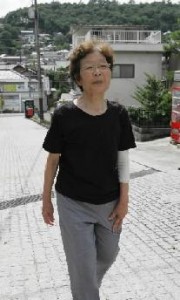Images of the Atomic Bombing, 1945~2007, Part 2
Jun. 27, 2010
Leg etched with the atomic bombing
by Masami Nishimoto, Senior Staff Writer
What were the consequences of the atomic bombing of Hiroshima? What consequences continue to linger on? This series [originally published in August 2007] traces the people linked to photographs which record the A-bomb devastation. With some voices in Japan now contending that the nation should arm itself with nuclear weapons, it is time to stress the reality of the destruction these weapons wreak.
Terrible pain of a cruel youth
This photograph was taken at the Hiroshima Red Cross Hospital on October 6, 1945. The photographer, Shunkichi Kikuchi, was in charge of still photos for the medical team dispatched by the Japan Film Corporation when it produced documentary films to record the atomic bombing of Hiroshima. In a note made about the picture, he wrote: "At the nurses' dormitory of the Japan Red Cross Society, she suffered multiple bone fractures when a post fell on her." Mr. Kikuchi protected his images from seizure by the American Occupation Forces, and died in 1990 at the age of 74. Hiroshima Peace Memorial Museum and the Chugoku Shimbun are working to digitalize the original 860 prints that were taken in 1945, with the assistance of the Hiroshima International Cultural Foundation. By tracing back the photography notes and other materials, the subject of this image turned out to be a 16-year-old nursing student.
Sachiko Tanaka, 78, a resident of Onomichi City, Hiroshima Prefecture, did not shy away from revealing her right leg in the photo that was taken soon after the bombing.
"The blackened area is where the incision was made," she explained. "Although the dressing was changed frequently, the wound became infested with maggots every time. It hurt so much that I begged my father to amputate my leg, but he and the head nurse only scolded me." A cruel youth had abruptly been thrust upon her.
Ms. Tanaka, then known by her maiden name, Matsuura, graduated from Onomichi Girls High School (now, Onomichi Higashi High School) in 1945, the year of the bombing, and enrolled in the Hiroshima Red Cross Society's First Rescue Nurse Training Program. On the morning of August 6, as she was preparing breakfast in the dormitory's dining room, her dream of wearing a white nurse's uniform was dashed in an instant.
She was 1.5 kilometers southeast of the hypocenter. The wooden dormitory collapsed and was soon engulfed in flames. But before it caught fire, she was dug out by a soldier who had been hospitalized there--she was told this later. Ms. Tanaka spent the night in front of the hospital's main entrance with other people who had been injured. She was then moved to the hospital building noted for the metal window frames that were twisted by the blast.
According to the first volume of the "Record of the Hiroshima A-bomb Disaster," published by the City of Hiroshima in 1971, 56 lives were lost at the Red Cross Hospital, including 22 nursing students. The book includes the following note: "The father of Sachiko Matsuura visited his seriously wounded daughter and fashioned a bathtub out in the sweet potato field."
Her father Teizaburo was 48 years old at the time. He came to Hiroshima from Onomichi in search of his daughter and visited her many times at the hospital. "He found a cast iron bathtub in the rubble and used it for the baths he made for me and other people," Ms. Tanaka explained.
With her father's encouragement, the daughter who could not rise from her bed after the bombing was able to endure. A classmate, still a friend today, cared for her, too, fighting sleep to pick off the maggots from her wound.
Ms. Tanaka finally left the hospital in May 1946. Her right leg, which had multiple fractures, became three centimeters shorter than the left leg when the broken bones fused back together. Because this impacted her mobility, she was forced to give up a career in nursing. She has a vivid memory of standing on the rooftop of the hospital, bidding farewell to the devastated city stretching before her.
She arrived home on crutches. Her mother Toshie then became bedridden as a result of venturing into the city immediately after the blast. She lived alone with her father and mother, and she felt depleted by fatigue while working in the kitchen in the heat of summer. They could barely make ends meet. Yet her mother told her, "We managed to survive so we must live a long life. August 6 will be our second birthday."
Ms. Tanaka got married in 1960. Her husband Atsuo, a company employee, wasn't concerned about her exposure to the atomic bombing, but they nevertheless gave a sigh of relief when their son and daughter were born healthy. Together they created a home that was filled with laughter.
Her husband passed away five years ago at the age of 78. Ms. Tanaka now has difficulty walking again due to her advancing age. She pulled through surgery for a cerebral aneurysm, but that has forced her to return to the hospital regularly. She finds peace of mind in faith, though reveals deeply-held regret when she says, "At times I think my life might have been different if I hadn't gone to Hiroshima to study."
"It was an attack on innocent people and brought about things that were unimaginable, like the black rain. It was completely cruel. But I wonder if people really grasp that."
Watching the Peace Memorial Ceremony of August 6 on TV, Ms. Tanaka saw two children speak and pledge that their generation "will not turn Hiroshima's experience into a story of long ago." She was deeply moved by this and she holds a strong hope that everyone will pledge to do the same.
(Originally published on August 10, 2007)









